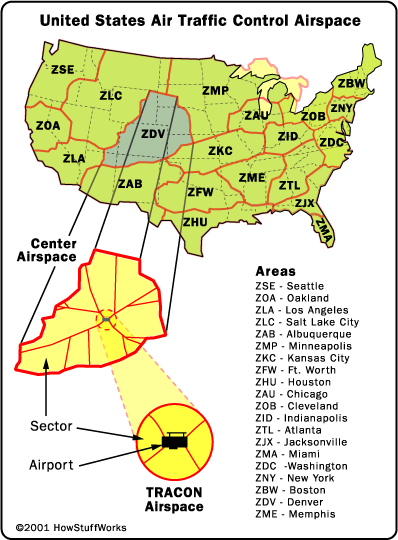NWR in Control Towers
Ok guys and gals... Here is my $0.02 in the matter...
As I was studying to become a pilot, yet I was unable to complete the program, this is what I know of the whole thing.
The weather reports come from Air Traffic Control, which is where that cool US map w/ the regions comes into play. They're the ones that study and report the weather, and redirect commercial flights en-route.
Most major airports have a Weather Service frequency that pilots are supposed to tune into and get the latest weather updates. However it is our equivalent to NOAA Weather Radio. It'll say the current conditions (thunderstorm, rain, fog, snow, etc), wind speed and direction, perhaps if the runways are only open for IFR (Instrument Flight Rules, where you trust the instruments in the plane to get you to the runway while you can't see a damn thing out the window), etc. It isn't necessarily real-time. In fact, at the end of each broadcast, they have a time identifier code, such as Zulu or Bravo, that changes every hour. So when a pilot contacts the tower or ATC, they say the latest code to tell the controller that they listened to the most recient report. I doubt it would say "There's a tornado on runway 2-9, don't land here idiots!"... and if it was an High-precip supercell, even the guys in the tower may not have a clue.
While I haven't checked yet, I'm sure the AOPA will be getting involved in this, that is if the controller's or their union or whatever speaks up. They lobby for pilots and aviation people to get stuff done, such as ending stupid laws that prohibit NWR in towers.
Personally, I think they should have at least one NWR w/ SAME alert on to help protect them. Just think if the tower was hit and people died, it would be all over the news and I'm sure every airport would have a weather radio in it. Now the FAA probably thinks that this would be a distraction to the controller's already hecktic job. They've been under fire lately for their own problems, which include that fatal regional jet crash in Kentucky, where only one tower controller was on duty (2 min is the FAA rule, but then they broke their own rule and made only one work that morning for some reason).
Anyway, this wouldn't stop me from flying. I love to fly and hopefully soon will be getting my license. Major airliners have radar built-in and some smaller planes. But like anything else, your features may vary and while it may show a little more detail than what you see on TV, I doubt it would show a clear hook echo, or even if the pilots would know what to look for.
A lot of things should have happened differently. No, the aircraft on approach should NOT have been coming in to land. I'm not sure what type of craft it was as I didn't see the whole story, but ATC or tower should of redirected them elsewhere. Tower probably thought it was just a heavy rainstorm and they were landing via instruments. FAA needs to look into this situation in more depth to realize that hey, some places actually need weather radios. And perhaps a basic storm spotter class for the tower controllers would help too.
Oh well, that's just my take on the deal...

Good hunting this season!
Joe / MO7374 (STL)

